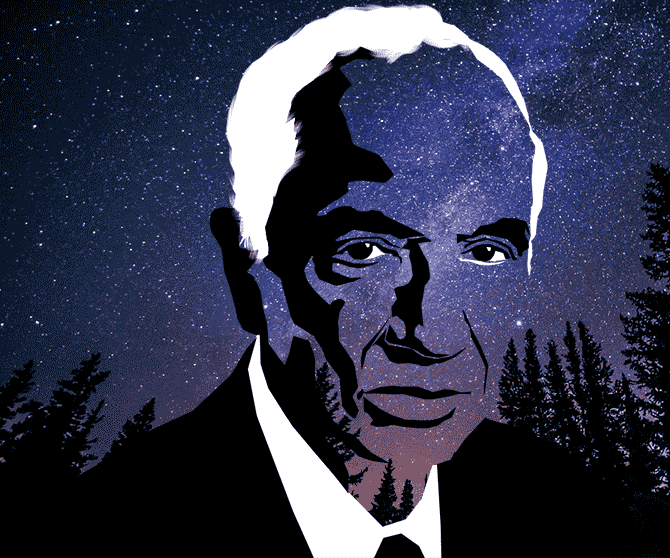The LIGO announcement -- which confirmed, among other things, that gold, platinum and other heavy metals were products of neutron star collisions -- came just before Subrahmanyan Chandrasekhar's 107th birthday.
Devangshu Datta on how a 19-year-old Indian first concluded how stars live and die.
Illustration: Dominic Xavier/Rediff.com

In July 1930, a 19 year old from Madras boarded a ship, heading for Trinity College, Cambridge. Subrahmanyan Chandrasekhar, who was born on October 19, 1910, was the son of C V Raman's brother, and reckoned a physics prodigy. He had already graduated.
His metier was astrophysics. On that journey, he came to some conclusions about the ways in which stars 'lived' and 'died'.
He would eventually win the Nobel Prize for the calculations initiated while on that voyage.
The latest news from the cutting edge of astrophysics confirms some of his theories. The LIGO (Laser Interferometer Gravitational-Wave Observatory) witnessed an epochal event on August 17 when it observed gravitational waves from two colliding neutron stars, Source GW170817 in NGC 4993, from 130 million light years away.
The data from the two LIGO labs in the US were confirmed by the new Italian facility, Virgo, which meant unprecedented accuracy. Many other observatories chimed in with visual and electromagnetic data.
Fittingly, many Indians were among the 1,500-odd scientists involved in generating the data and making sense of it.
This event confirmed, among other things, that gold, platinum and other heavy metals were products of neutron star collisions.
In fact, as the song goes, 'We are all (literally) made of stars.'
Stars take hydrogen -- the simplest, lightest and most abundant element -- and turn it into helium through nuclear fusion.
Two hydrogen atoms are compressed and fused into one helium atom with the excess released as energy.
That's the sunlight and heat that we depend on.
As a star gets older, it starts running out of hydrogen. It uses helium in another fusion reaction to create beryllium.
After that, the fusion of beryllium with helium creates carbon, and carbon fusion with helium creates oxygen, and so on.
At each stage, fusion creates heavier elements. However, scientists weren't sure where the really heavy elements were created (an element gets heavier if it has a more complex atom with more particles).
When a star 'dies', matter is recycled.
Stars die in two (and a half) ways. Some go out with a very big bang (a supernova), some with a bang (nova); others wink out with a whimper (white dwarfs). It depends on how massive the star is.
A relatively small star -- something about the mass of the sun or little more -- collapses and becomes a white dwarf. That's a small blob of very dense matter. About 97 per cent of stars turn into white dwarfs.
More massive stars die in a much more spectacular way. A massive star collapses until it becomes unstable, and goes nova or supernova, blowing up in a huge explosion. That releases a massive burst of light and energy.
For a brief while a supernova can release more energy than the rest of the observed universe.
Matter is hurled out, travelling through space at great speeds. Those recycled elements get 'captured' and turn into planets.
After a supernova, what remains is compressed into progressively smaller space. It turns into a very small, very dense core stripped down to neutrons.
Neutron stars may be more massive than the sun but just occupy the same volume of space as a small city.
A teaspoon of neutron star material would have about 10 billion kg of mass.
If there's a lot of material left, compression doesn't stop at that stage. The core collapses to form a black hole.
When two stars are close together in the same system, it's called a binary system.
When a binary goes supernova, we get two neutron stars and those can collide and merge into one.
These observations confirmed that collapsing neutron stars release short intense bursts of gamma rays. It also confirmed that gravitational waves travel at the same speed as electromagnetic waves and light, just as Einstein had predicted.
Spectrum analysis of the material spewed out showed the signature of newly-created elements such as gold and platinum, confirming that it is indeed such events that create many of the heavy elements.
Chandrasekhar was the man who calculated the critical mass at which stars go unstable.
Stars above what is now called the Chandrasekhar Mass Limit (CML) -- about 1.4 times the mass of our sun -- go nova.
Stars below the CML become white dwarfs.
NASA's Chandra X-Ray Observatory was at the forefront of the many observatories working on the neutron star collision.
Chandra detected X-rays after the event, confirming that this is also a characteristic of such collisions.
The LIGO announcement came during the festive season, just before Chandrasekhar's 107th birthday.
This was fitting given that it tells us where precious metals come from and why these are so rare.
Now we know that jewellers, superstitious or not, can really thank the stars!










